Scientific debate can be soured by the tendency for evangelical pioneers to see any questioning as opposition bordering on evil. Their aggressive attitude can delay innovation, a lesson perhaps for our own times and a reason for studying history, says Mike Davidson.

Ignaz Semmelweis
My wife and I saw the production “Dr Semmelweis” at the Bristol Old Vic. At last, a chance to experience live theatre with a full audience; it also fulfilled my interest in the history of medicine. The writers, Mark Rylance and Stephen Brown, were influenced by the 1952 biography Semmelweis (1818-1865) by Louis-Ferdinand Céline, a work I am unfamiliar with.
Their play is a dramatic interpretation of the work of Ignaz Semmelweis (1818–1865) on puerperal sepsis and his failure to convince his contemporaries of the need for ward hygiene to control the disease. This was in no small part a result of his uncompromising personality and ability to alienate even his strongest supporters and allies.
Semmelweis proposed the practice of washing hands with chlorinated lime solutions in 1847 while working in Vienna General Hospital’s First Obstetrical Clinic, where doctors’ wards had three times the mortality of midwives’ wards. His observations brought him into conflict with many within the contemporary scientific and medical establishment.
The play records Semmelweis’s descent into madness, haunted by the ghosts of the women he has not saved. The ghosts are portrayed as dancers and musicians on stage and within the audience, as he recollects events. Much of the narrative takes the form of flashbacks acted out for his wife. The opportunities for engagement squandered by Semmelweis due to his lack of understanding of human nature are highlighted.
Rylance’s performance as Semmelweis was central and powerful and the cast provided strong support. I found two female performances poignant, Thalissa Teixeira, as his wife Maria, and Jackie Clune, as nurse Muller. The female characters provide a more balanced view of history than concentrating on male pioneers.
Muller is a senior midwife who helps Semmelweis with his introduction of hygiene methods and provides clinical data to support his thesis. His lack of empathy for her guilt in accidentally causing an outbreak of sepsis that contributed to her ultimate suicide speaks volumes of the single-mindedness and unforgiving attitude of Semmelweis.
There is a very pertinent observation by Rylance in an interview published in the Financial Times on 12 January 2022: “He wasn’t just a victim. He was also a very difficult person: someone who got very angry about people not understanding him and became his own worst enemy. Which maybe a lot of pioneers are — they’re people who cut through and are not the most polite or politically savvy people.”
The production at Bristol has now ended but given the enthusiastic reception it got there, it may be staged again.
I recommend the play not only for a medical history enthusiast but for anyone who wants to experience a thought-provoking performance by a talented cast, playwrights, dancers and musicians.
Mike Davidson is President of the British Society for the History of Medicine.






 set up a prominent engineering firm. He developed a practice in cardiothoracic surgery, performing over 100 heart operations a year by the 1950s. However, many cases of heart valve disease, including those resulting from regurgitation (leaking) rather than stenosis (narrowing), remained inoperable and often fatal.
set up a prominent engineering firm. He developed a practice in cardiothoracic surgery, performing over 100 heart operations a year by the 1950s. However, many cases of heart valve disease, including those resulting from regurgitation (leaking) rather than stenosis (narrowing), remained inoperable and often fatal.
 Chesterman realised cardiopulmonary bypass would be key to further procedures of this kind. He subsequently visited Walton Lillehei and Richard De Wall in the US, who had developed the pump oxygenator. Chesterman went on to build and use his own machine in Sheffield on 26 February 1957, one of the first outside America to do so. (Figure 4)
Chesterman realised cardiopulmonary bypass would be key to further procedures of this kind. He subsequently visited Walton Lillehei and Richard De Wall in the US, who had developed the pump oxygenator. Chesterman went on to build and use his own machine in Sheffield on 26 February 1957, one of the first outside America to do so. (Figure 4)  As well as technological contributions, Chesterman’s legacy includes the subsequent flourishing of a cardiothoracic unit in Sheffield, now housed in the Chesterman Wing at the Northern General Hospital. In addition, he had an interest in archaeology and, after retiring from clinical practice, he founded the University of Sheffield Osteology Laboratory.
As well as technological contributions, Chesterman’s legacy includes the subsequent flourishing of a cardiothoracic unit in Sheffield, now housed in the Chesterman Wing at the Northern General Hospital. In addition, he had an interest in archaeology and, after retiring from clinical practice, he founded the University of Sheffield Osteology Laboratory.